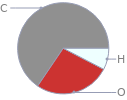Input interpretation

ethyl 3-(3, 4-dimethoxyphenyl)propionate | elemental composition
Result

Find the elemental composition for ethyl 3-(3, 4-dimethoxyphenyl)propionate in terms of the atom and mass percents: atom percent = N_i/N_atoms × 100% mass percent = (N_im_i)/m × 100% Plan: • Write the chemical formula and gather atomic masses from the periodic table. • Determine values for N_i, m_i, N_atoms and m using these items. • Finally, compute the percents and check the results. Write the chemical formula: (CH_3O)_2C_6H_3CH_2CH_2CO_2C_2H_5 Use the chemical formula to count the number of atoms, N_i, for each element and find the total number of atoms, N_atoms, per molecule: | number of atoms C (carbon) | 13 H (hydrogen) | 18 O (oxygen) | 4 N_atoms = 13 + 18 + 4 = 35 Divide each N_i by N_atoms to calculate atom fractions. Then use the property that atom fractions must sum to one to check the work: | number of atoms | atom fraction C (carbon) | 13 | 13/35 H (hydrogen) | 18 | 18/35 O (oxygen) | 4 | 4/35 Check: 13/35 + 18/35 + 4/35 = 1 Compute atom percents using the atom fractions: | number of atoms | atom percent C (carbon) | 13 | 13/35 × 100% = 37.1% H (hydrogen) | 18 | 18/35 × 100% = 51.4% O (oxygen) | 4 | 4/35 × 100% = 11.4% Look up the atomic mass, m_i, in unified atomic mass units, u, for each element in the periodic table: | number of atoms | atom percent | atomic mass/u C (carbon) | 13 | 37.1% | 12.011 H (hydrogen) | 18 | 51.4% | 1.008 O (oxygen) | 4 | 11.4% | 15.999 Multiply N_i by m_i to compute the mass for each element. Then sum those values to compute the molecular mass, m: | number of atoms | atom percent | atomic mass/u | mass/u C (carbon) | 13 | 37.1% | 12.011 | 13 × 12.011 = 156.143 H (hydrogen) | 18 | 51.4% | 1.008 | 18 × 1.008 = 18.144 O (oxygen) | 4 | 11.4% | 15.999 | 4 × 15.999 = 63.996 m = 156.143 u + 18.144 u + 63.996 u = 238.283 u Divide the mass for each element by m to calculate mass fractions. Then use the property that mass fractions must sum to one to check the work: | number of atoms | atom percent | mass fraction C (carbon) | 13 | 37.1% | 156.143/238.283 H (hydrogen) | 18 | 51.4% | 18.144/238.283 O (oxygen) | 4 | 11.4% | 63.996/238.283 Check: 156.143/238.283 + 18.144/238.283 + 63.996/238.283 = 1 Compute mass percents using the mass fractions: Answer: | | | number of atoms | atom percent | mass percent C (carbon) | 13 | 37.1% | 156.143/238.283 × 100% = 65.53% H (hydrogen) | 18 | 51.4% | 18.144/238.283 × 100% = 7.614% O (oxygen) | 4 | 11.4% | 63.996/238.283 × 100% = 26.86%
Mass fraction pie chart

Mass fraction pie chart